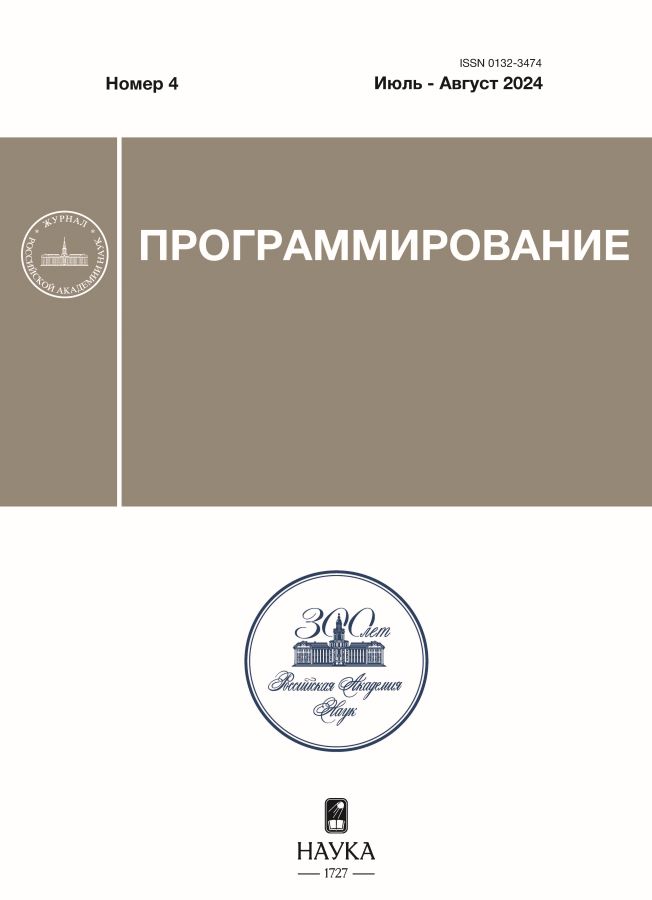Nº 4 (2024)
- Ano: 2024
- Artigos: 4
- URL: https://modernonco.orscience.ru/0132-3474/issue/view/12756
Edição completa
INFORMATION SECURITY
Comparative efficiency analysis of hashing algorithms for applications in zk-SNARK circuits in distributed ledgers
Resumo
The paper presents a comparative efficiency analysis of hashing algorithms in terms of applicability in zk-SNARK based systems. We have considered the hash functions sha256, sha3, blake2, mimc and poseidon, which are most widely used in modern distributed ledgers. To conduct experiments with measuring parameters, an infrastructure based on the ZoKrates toolbox was developed. A series of measurements with different input data was carried out for each algorithm. The number of constraints in the R1CS representation of the algorithm, the length of the proof key and the verification key, the running time of the setup phase of the protocol, and the proof generation time were measured. Based on the obtained results, we determined the boundaries of the practical applicability of algorithms for the problem of proving the knowledge of the preimage of a hash function using zk-SNARK circuits in distributed ledgers, and also identified emerging efficiency problems.
 3-12
3-12


COMPUTER GRAFICS AND VISUALIZATION
Constructing the internal Voronoi diagram of a polygonal figure using the sweep method
Resumo
The article considers the problem of constructing the internal Voronoi diagram of a polygonal figure – a polygon with polygonal holes. A method based on the flat sweeping paradigm is proposed. Direct construction of only the internal part of the Voronoi diagram allows us to reduce the amount of calculations and increase robustness compared to known solutions. Another factor in reducing computational complexity is the use of the property of pairwise incidence of linear segments formed by the sides of a polygonal figure. To take these features into account, it is proposed to build the data structure Status of the sweeping line in the form of an ordered set of sites’ areas of responsibility. The structure is implemented as a combination of a balanced tree and a bidirectional list. Computational experiments illustrate the numerical reliability and efficiency of the proposed method.
 13-26
13-26


SOFTWARE ENGINEERING, TESTING AND VERIFICATION OF PROGRAMS
Analytical review of confidential artificial intelligence: methods and algorithms for deployment in cloud computing
Resumo
The technologies of artificial intelligence and cloud systems have recently been actively developed and implemented. In this regard, the issue of their joint use, which has been topical for several years, has become more acute. The problem of data privacy preservation in cloud computing acquired the status of critical long before the necessity of their joint use with artificial intelligence, which made it even more complicated. This paper presents an overview of both the artificial intelligence and cloud computing techniques themselves, as well as methods to ensure data privacy. The review considers methods that utilize differentiated privacy; secret sharing schemes; homomorphic encryption; and hybrid methods. The conducted research has shown that each considered method has its pros and cons outlined in the paper, but there is no universal solution. It was found that theoretical models of hybrid methods based on secret sharing schemes and fully homomorphic encryption can significantly improve the confidentiality of data processing using artificial intelligence.
 27-40
27-40


RuGECToR: rule-based neural network model for russian language grammatical error correction
Resumo
Grammatical Error Correction is one of the core Natural Language Processing tasks. At the moment, the open source state-of-the-art Sequence Tagger for English is GECToR model. For the Russian language, this problem does not have solutions with the same good results due to the lack of labeled datasets, therefore we decided to contribute to the aforementioned task. In this research, we described the process of creating a synthetic dataset and training a model on it. We adapt GECToR architecture for Russian language and call it RuGECToR. We use this architecture because, unlike Sequence-to-Sequence approach, it is easy to interpret and does not require a lot of training data. Our goal was to train the model in such a way that it does not adapt to a specific sample, but generalizes the morphological properties of the language. The presented model achieves an F0.5 of 82.5 on synthetic data and an F0.5 of 22.2 on RULEC dataset which was not in the training set.
 41-48
41-48












